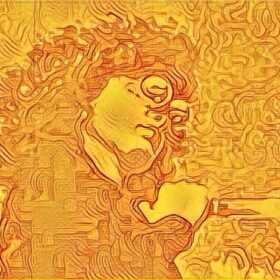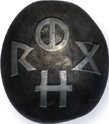13th Age
13th Sage: There’s No Such Thing as a Shadow Mongoose
 By Rob Heinsoo and ASH LAW
By Rob Heinsoo and ASH LAW
At the Gen Con 2014 Monster Design workshop, ASH LAW, Gareth Ryder-Hanrahan, and I collaborated with the audience to create a new 13th Age monster from scratch. It was great fun, and our audience-collaborators all signed my black book so that we could list their names at the end of this piece to say thank you!
ASH took notes on the results of the design workshop, wrote up the agreed-upon mechanics, and added the adventure ideas appearing below. True clue: if an adventure idea looks like a play on a book or movie title/plot, there’s a high probability ASH was behind it!
There’s a good deal of text below, but the monster is not actually complex. It’s just weird and different, and needs to be fully explained. As you’ll see from the story ideas that follow, the workshop explored the routes by which one compelling monster can twist a campaign, much like a character’s One Unique Thing.
–Rob Heinsoo
Shadow Mongoose
 A coiling mass of corporeal shadow, commonly referred to as a mongoose because of speed, aggressiveness, and persistent legends that they’re the ancient enemies of the nagas. That would explain why the nagas seem to have lost or hidden all their eggs . . . .
A coiling mass of corporeal shadow, commonly referred to as a mongoose because of speed, aggressiveness, and persistent legends that they’re the ancient enemies of the nagas. That would explain why the nagas seem to have lost or hidden all their eggs . . . .
8th level spoiler [elemental]
Initiative: +15
Rikki-tikki-claw-claw +13 vs. AC—24 damage
Natural even hit: Make a second rikki-tikki-claw-claw attack as a free action.
[quick action] Theft of fate +13 vs. MD (one target that has been hit twice by the shadow mongoose this battle)—The shadow mongoose steals an icon die from the target. The target may not use the stolen icon die, until the shadow mongoose gives it back, or the shadow mongoose dies.
Crit: …and the relationship that the adventurer has with that icon flips from positive to negative or negative to positive. Conflicted relationships are unaffected.
Shadow speed: As a move action the shadow mongoose may teleport into engagement with a target that it missed the previous round.
Play dead: Once per battle the shadow mongoose may fake being dead. Only magical senses and a DC 25 skill roll from the PC who struck the ‘killing blow’ will detect that the creature is still alive. Shadow mongooses like to fake their deaths so that they can escape battle with their stolen icon relationships. Since shadow anatomy isn’t entirely biological, this ability functions like fleeing the battle if it succeeds, the PCs can go ahead and blast away at what they think is the corpse, but they’ll be fragging the mongoose’s shadows, not the mongoose itself.
Trickster: The shadow mongoose can change shape, though not mid-battle. Shadow mongooses sometimes join adventuring parties as helpful hirelings, love interests, or local guides in order to repeatedly steal icon relationships from adventurers.
Nastier Specials
Drop the loot: The shadow mongoose flees the battle. One nearby enemy of the shadow mongoose gains an unwanted icon relationship worth 1d3 icon dice. This new relationship is temporary, lasting only until the end of the next game session.
AC 21
PD 18 HP 188 (see Shadow fate)
MD 22
Shadow fate: When the shadow mongoose dies all the icon relationship dice that it stole return to their owners. The person who killed the shadow mongoose gains 1d3 ‘5’ icon dice results with a random icon that they do not have a relationship with OR a 6 with the Prince of Shadows if they do not have a relationship with him (roll 1d3 for relationship type: 1= Negative, 2= Conflicted, 3= Positive).
Lost icon of nagas
It may be that there was once an icon that was somehow related to the nagas, a Duke of Nagas. If that was the case then it was ‘defeated’ by the shadow mongooses, its power and influence stolen away piece by piece by the shadow mongooses. Even today the shadow mongooses have an enmity with the wise nagas, stealing their eggs and destroying their crystal libraries.
Ancient icon results
Shadow mongooses live for a very long time, and might have stolen icon relationships with the Duke of Nagas or another ancient icon like the Dream Princess, the Dark Jester, or anything else you feel like introducing into the game. Perhaps there was an ogre icon, or a divine platinum dragon, or an icon that was a dark spider goddess. Whatever you pick, killing a shadow mongoose might give you a temporary icon relationship with that ancient icon. Exactly what that means for your game is up to you.
Elemental shadow, the rise of an icon
We’ve put this creature’s type as ‘elemental’ and said that it is made of shadow. That means shadow is an element, alongside Earth, Wind, Fire, and Water. There are a couple of other shadow-themed creatures in 13th Age (such as the shadow dragon, shadow thieves, etc) and if you do decide to go with shadow-as-an-element then you might want to switch them to shadow elementals too.
What does it mean that shadow is an element? Druid elemental caster mechanics don’t reference shadow, nothing else links to it, so what’s up?
Well, if you decide that shadow is an element, then shadow mongooses might be its heralds. Perhaps the element of shadow is on the rise, growing in power and warping the world. This ties shadow mongooses into end-of-the-age style plots, where the status quo is upended and a new order is ushered in. Exactly how this links to the mysterious Prince of Shadows is up to you: maybe he’ll become a Shadow King; or maybe he is the remnant of a lost time of shadows working to bring back the elemental shadow; or maybe he’s secretly a shadow mongoose trickster.
If you don’t like that idea, then switch the creature type to undead or beast—though these creatures don’t really feel like either, so maybe make this creature an aberration. Yes, aberration feels like the best fit here, if you don’t like the idea as shadow-as-an-element.
Indispensable allies
Referenced in the mechanics is the fact that shadow mongooses like to join adventuring parties or befriend them in order to steal their icon relationships. The shadow mongoose might be a friendly tavern owner who lets the adventurers stay with her free of charge, a love interest for one of the adventurers, a local guide, a wise sage ready to offer advice, or a plucky young henchman who wants to one day be just like his heroes (the adventurers). Shadow mongooses don’t need to kill adventurers, they just want to steal their icon relationships; it is in the best interests of a shadow mongoose to help adventurers out. As far as the shadow mongoose is concerned, adventurers are the proverbial geese who lay golden eggs.
At the GenCon 2014 panel where this monster was created some of the audience wanted to have some way to detect shadow mongooses, and the idea of some tell-tale sign was talked about… though we never got around to specifying just what that sign might be.
ASH says: For some reason it sticks in my mind that the shadow mongoose is a consummate shape-changer and trickster that can never change its eyes.
Rob says: Eyes seem like too much of a give-away. I’d probably say that every mongoose has a tell, but it’s always different, and you usually don’t figure it out until after the mongoose has been exposed. One mongoose always smells just a bit like cinnamon the first time you meet it, another whistles that ancient tune called Dreams of a Lost Age, and so on.
Iconic Crystals
What do shadow mongooses do with their stolen icon relationships? Again at GenCon, the idea of iconic crystals was raised: some sort of egg-like geode that allows the owner to mystically alter their fate and gain the aid of icons. If this is so then maybe they can be traded with other creatures to gain their aid, or even swapped with adventurers. Certainly a crystal-filled stone egg that gives you an icon relationship die is an unusual treasure.
Adventure seeds
Love in the time of shadows. A shadow mongoose tricks a party member into falling in love with it, only to later fall in love with the adventurer for real. Now it works to protect the party while attempting to avoid its secret being revealed. The party is constantly plagued with mysterious happening, strange co-incidences, and sightings of shadowy creatures.
Raiders of the lost egg. The race is on for an iconic crystal said to grant a relationship with the Wizard King. The adventurers must beat rival groups to get it for an icon, and claim their reward. Not only are agents of all the icons involved in the race to the lost egg, but a shadow mongoose has slipped into one of the parties.
The ape slaves of howling island. A shadow mongoose has made a tidy fortune as one of its assumed identities as a writer of sensationalist adventure stories, with lurid titles such as ‘the dragon of vengeance’ and ‘the lost treasure of curse castle’. The shadow mongoose, seeking new material, joins the party to chronicle its adventures (and sneakily steal icon relationship dice).
The temple of phantom shadows. A shadow mongoose openly approaches the party, revealing its true self. It wants them to open up an ancient tomb and retrieve the golden statue of a goblin found therein—they can keep the rest of the treasure for themselves. Obviously it is a trick of some sort, so what does the shadow mongoose really want?
The unicorn’s legacy. The owner of the Prancing Unicorn tavern in Concord has been discovered to be a shadow mongoose and has fled the city. The adventurers find themselves, as they have the largest bar tab, to be the inheritors of both the Prancing Unicorn and the large debt on the property. Now the party must settle a debt not theirs, run a tavern, avoid suspicion that that are shadow mongooses, and keep an eye out for the return of the true shadow mongoose.
Tricksters abound. An ancient naga is headed to Horizon to meet with a college of wizardry and share its knowledge. The adventurers are hired to provide security for the meeting, which will take several days. Just after the naga arrives one of the wizards turns up dead, their body disintegrated. The adventurers know that at least one of the wizards is an imposter, but who?
Final Thanks
When your player character has lost their connection to the Priestess because of a whirling shadow beast they could have sworn they’d killed twice, here are the people you’ll want to thank at GenCon!
Ben Roby
Brad Main
Dave Thompson
Jack Kessler
Jim Davis
K8 Evans
Kyle Rimmer
Michael Mineval
Sarah Miller
Steven Warzeha
Wade Rockett
Yoel Rodriguez
———————-
13th Age combines the best parts of traditional d20-rolling fantasy gaming with new story-focused rules, designed so you can run the kind of game you most want to play with your group. Created by Rob Heinsoo and Jonathan Tweet, 13th Age gives you all the tools you need to make unique characters who are immediately embedded in the setting in important ways; quickly prepare adventures based on the PCs’ backgrounds and goals; create your own monsters; fight exciting battles; and focus on what’s always been cool and fun about fantasy adventure gaming. Purchase 13th Age in print and PDF at the Pelgrane Shop.



 By Rob Heinsoo and ASH LAW
By Rob Heinsoo and ASH LAW